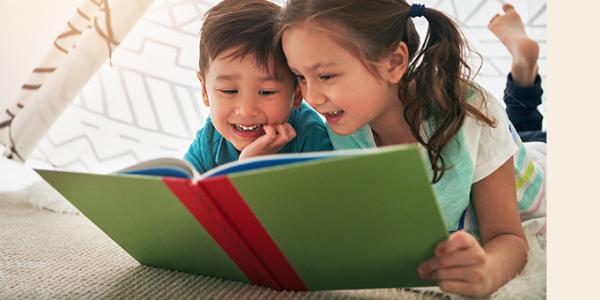Read Together to Support Early Literacy

You are here
Children who have lots of experiences with books absorb the rhythms and patterns of language and, at surprisingly early ages, begin to imitate the language and gestures their parents and caregivers use while sharing stories, sometimes turning pages and murmuring as they “read” the pictures.
While we can’t expect infants and toddlers to learn to read and write yet, they are nevertheless developing skills that provide a foundation for later literacy. When you share books with your very young child you support emerging literacy as you:
- help your child learn that pictures and words are symbols that can be interpreted;
- expose your child to new words, thereby increasing her vocabulary; and
- familiarize your child with the conventions of print.
Understanding pictures and print as symbols
Within their first 18 months, most infants who have explored and shared books with adults show an understanding that pictures symbolize things in the real world, an understanding that is uniquely human (Barton & Brophy-Herb 2006). For example, at around 12 months, an infant seems to understand that the cup in a picture on the page represents a cup like the one she drinks from every day. She may tell you about the connection she is making by looking at the picture and pointing to a nearby cup. Another child, age 17 months, enjoying the book Goodnight Moon with his dad, may murmur, “Hush,” when his dad turns to the page about a quiet old lady who was whispering, “Hush” (Schickedanz 1999). Understanding that pictures are symbols of real things is a first step toward understanding that print also represents ideas of items in the real world.
Children may begin to notice print in addition to pictures between 15 and 20 months, and by 32 months a child may move a finger or her whole hand across a line of print and verbalize her memory of what the text says (Schickedanz 1999). Although we might find constantly answering the question, “What say?” exhausting, children’s recognition that pictures and print convey meaning is an important step in emerging literacy that we need to support by responding to their inquiries (Neuman, Copple, & Bredekamp 2000).
Increasing vocabulary
Sharing books will expand your very young child’s growing vocabulary. Storybooks often use words in ways that are different from how we use those same words in everyday conversation. Books also use words that are generally absent from day-to-day speech. The Napping House, for example, contains many descriptive words related to napping, such as slumbering, snoozing, and dozing, which adults may rarely use in a conversation with a child. By hearing new words in the context of a story and having them explained by an adult, children’s word comprehension will grow, and they will eventually incorporate new words into their spoken vocabularies.
Learning the conventions of print
Through early exposure to books, children begin to learn about the conventions of reading in their own language. For example, very young children using books in English learn that they are read from front to back, from the left of the page to the right, and from the top of the page to the bottom. Books in some other languages have different print conventions. Children learn that books have names (or “titles”) and that they are written by “authors.” Some older toddlers might be interested in books whose layouts break the rules; for example, books that are read from back to front, from right to left, or up and down the page in vertical columns.
Using Knuffle Bunny
References
Barton, L.R., & H.E. Brophy-Herb. 2006. “Developmental Foundations for Language and Literacy from Birth to Three Years.” In Learning to Read the World: Language and Literacy in the First Three Years, eds. S.E. Rosenkoetter & J. Knapp-Philo, 15–60. Washington, DC: Zero to Three.
Neuman, S.B., C. Copple, & S. Bredekamp. 2000. Learning to Read and Write: Developmentally Appropriate Practices for Young Children. Washington, DC: NAEYC.
Schickedanz, J. 1999. Much More than the ABCs: The Early Stages of Reading and Writing. Washington, DC: NAEYC.
Adapted from Birckmayer, J., A. Kennedy, & A. Stonehouse. 2008. From Lullabies to Literature: Stories in the Lives of Infants and Toddlers. Washington, DC: NAEYC, 45–46.